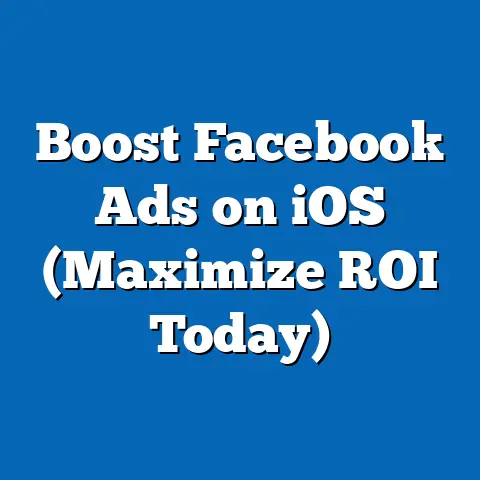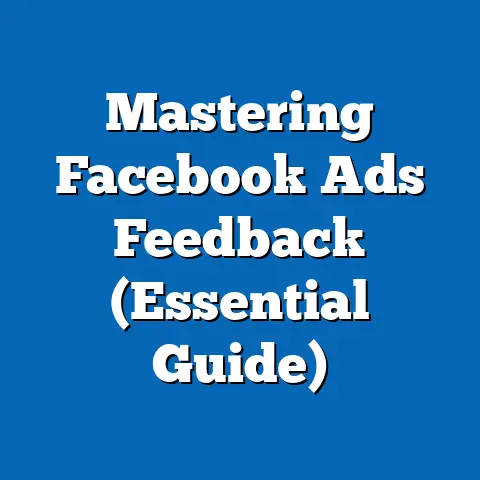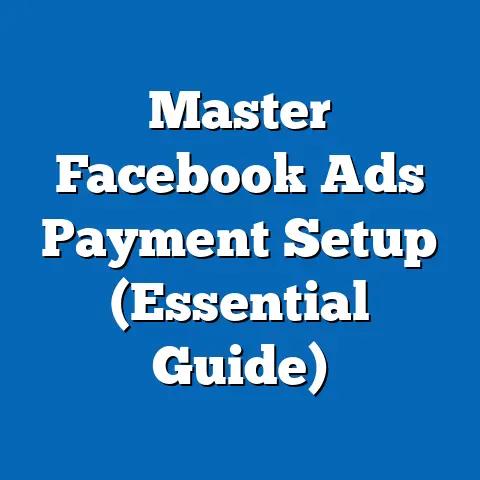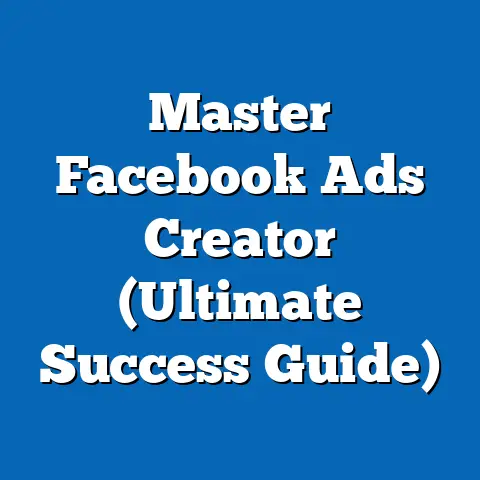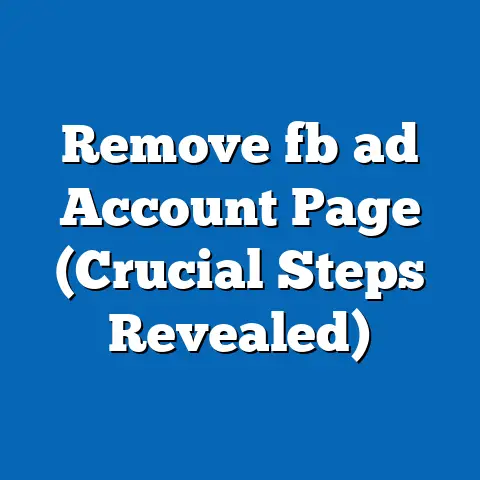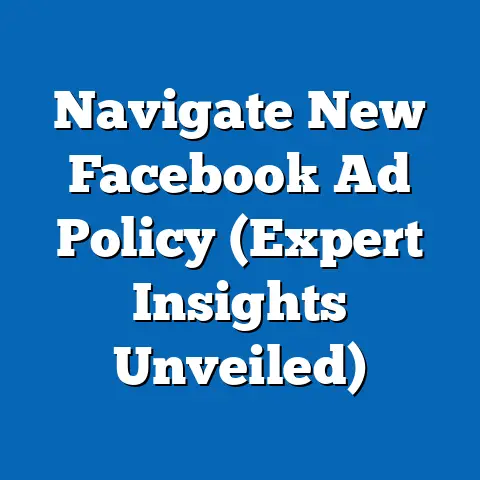Boost Hiring Game with Facebook Ads (Proven Strategies)
The modern job market is a battlefield. Competition for top talent is fierce, and traditional methods like job boards and print ads are simply not cutting it anymore. In a world dominated by social media, companies need to think outside the box and meet potential candidates where they spend their time – online. That’s where Facebook ads come in.
I’ve seen firsthand how effectively Facebook can be leveraged for recruitment. Remember that time I was consulting for a tech startup struggling to find qualified software engineers? They were relying solely on LinkedIn, which, while valuable, was proving to be too narrow in its reach. We decided to experiment with Facebook ads, targeting individuals with specific coding skills, interests in tech conferences, and even those who liked pages related to their competitor companies. The results were astounding! Within weeks, they had a flood of applications from highly qualified candidates, ultimately leading to several key hires that propelled their business forward.
Facebook, with its massive user base and sophisticated targeting capabilities, offers a unique opportunity to reach a diverse pool of potential employees. It’s not just about posting job openings; it’s about crafting compelling narratives, showcasing your company culture, and engaging with candidates on a personal level.
Section 1: Understanding Your Target Audience
Before you even think about creating an ad, you need to deeply understand who you’re trying to attract. Simply posting a job description and hoping for the best is a recipe for wasted ad spend and unqualified applicants. Defining your ideal candidate is the crucial first step in crafting a successful Facebook ad campaign.
Think of it this way: would you market a high-end sports car to someone who primarily drives a minivan? Of course not! The same principle applies to recruitment. You need to tailor your message to resonate with the specific skills, experience, and values of your target audience.
Creating Candidate Personas
Candidate personas are fictional, generalized representations of your ideal candidates. They go beyond simple job titles and delve into the motivations, aspirations, and online behaviors of the individuals you want to attract. To create effective candidate personas, consider the following:
- Demographics: Age, gender, location, education level, and work experience.
- Interests: What are their hobbies? What websites do they visit? What Facebook pages do they like?
- Skills: What technical skills, soft skills, and industry knowledge are essential for the role?
- Values: What are they looking for in a company culture? Do they prioritize work-life balance, career growth, or social impact?
- Online Behavior: Where do they spend their time online? What social media platforms do they use? What kind of content do they engage with?
For example, let’s say you’re hiring a marketing manager. Your candidate persona might look like this:
Name: Sarah Miller
Age: 32
Location: Austin, Texas
Education: MBA in Marketing
Experience: 5+ years of experience in digital marketing, with a focus on social media and content marketing.
Interests: Digital marketing trends, social media strategy, content creation, data analytics, technology, travel, and fitness.
Skills: Social media management, content marketing, SEO, SEM, email marketing, data analysis, project management, and leadership.
Values: Innovation, creativity, continuous learning, collaboration, and making a positive impact.
Online Behavior: Actively engages on LinkedIn, Facebook, Instagram, and Twitter. Follows industry blogs and influencers. Attends digital marketing conferences and webinars.
Leveraging Facebook’s Audience Targeting Features
Once you have a clear understanding of your ideal candidate, you can leverage Facebook’s powerful audience targeting features to reach them. Facebook offers a wide range of targeting options, including:
- Demographic Targeting: Target users based on age, gender, location, education, job title, industry, and more.
- Interest Targeting: Target users based on their interests, hobbies, and the pages they like on Facebook.
- Behavior Targeting: Target users based on their online behavior, such as purchase history, device usage, and travel habits.
- Custom Audiences: Upload a list of existing customers or employees to create a custom audience. You can then target this audience directly or use it to create a Lookalike Audience.
- Lookalike Audiences: Facebook will identify users who share similar characteristics with your existing customers or employees. This is a powerful way to expand your reach and find new potential candidates who are likely to be a good fit for your company.
How to Create a Lookalike Audience:
- Go to Ads Manager: Navigate to the “Audiences” section in Facebook Ads Manager.
- Create a New Audience: Click “Create Audience” and select “Lookalike Audience.”
- Choose Your Source: Select your existing customer list, website visitors, or Facebook page followers as the source for your Lookalike Audience.
- Select Your Location: Choose the countries or regions you want to target.
- Choose Your Audience Size: Select the percentage of the population you want to reach. A smaller percentage (e.g., 1%) will result in a more targeted audience, while a larger percentage (e.g., 10%) will result in a broader audience.
- Create Your Audience: Click “Create Audience” to finalize the process.
Tailoring Ads Based on Specific Attributes
The key to successful Facebook advertising is relevance. Your ads should speak directly to the needs and interests of your target audience. This means tailoring your ad copy, visuals, and call-to-action to resonate with their specific attributes.
For example, if you’re targeting millennials, you might use a more casual and conversational tone in your ad copy. You might also highlight the company’s commitment to social impact and sustainability. On the other hand, if you’re targeting experienced professionals, you might focus on career growth opportunities and competitive compensation packages.
I once worked with a construction company struggling to find skilled tradespeople. Their initial ads were generic, simply listing job openings and basic requirements. After conducting thorough audience research, we discovered that many potential candidates were active in online forums and Facebook groups related to their trades. We created targeted ads that spoke directly to their specific skills and experience, highlighting the company’s commitment to safety and providing opportunities for professional development. The result was a significant increase in qualified applicants.
Key Takeaway: Defining your ideal candidate and leveraging Facebook’s audience targeting features are essential for creating effective recruitment ad campaigns. By tailoring your message to resonate with the specific attributes of your target audience, you can increase your chances of attracting the best talent to your organization.
Next Step: Start creating detailed candidate personas for each of your key roles. Use Facebook’s audience insights tool to gather data on your target audience and refine your targeting strategy.
Section 2: Crafting Compelling Ad Content
You’ve identified your ideal candidate and defined your target audience. Now, it’s time to craft compelling ad content that captures their attention and motivates them to apply. In today’s noisy digital landscape, your ads need to stand out from the crowd and deliver a clear, concise, and persuasive message.
Elements of Effective Ad Copy
Effective ad copy is more than just a description of the job opening. It’s a carefully crafted message that speaks directly to the needs and aspirations of your target audience. Here are some key elements to consider:
- Attention-Grabbing Headline: Your headline is the first thing potential candidates will see, so it needs to be eye-catching and compelling. Use strong verbs, intriguing questions, and relevant keywords to grab their attention.
- Example: “Software Engineers: Build the Future with Us!” or “Dreaming of a Career with Impact? We’re Hiring!”
- Clear Value Proposition: What’s in it for the candidate? Why should they choose your company over the competition? Highlight the unique benefits of working for your organization, such as competitive salaries, generous benefits, opportunities for growth, a positive work environment, or a chance to make a difference.
- Example: “Join our team and enjoy competitive salaries, comprehensive benefits, and the opportunity to work on cutting-edge technology.”
- Strong Call to Action: Tell candidates exactly what you want them to do. Use clear and concise calls to action, such as “Apply Now,” “Learn More,” or “Visit Our Careers Page.”
- Example: “Ready to take your career to the next level? Apply Now!”
- Example: “Software Engineers: Build the Future with Us!” or “Dreaming of a Career with Impact? We’re Hiring!”
- Example: “Join our team and enjoy competitive salaries, comprehensive benefits, and the opportunity to work on cutting-edge technology.”
- Example: “Ready to take your career to the next level? Apply Now!”
I remember working with a small marketing agency that was struggling to attract top talent. Their ad copy was bland and generic, simply listing job requirements and basic responsibilities. After reviewing their ads, I suggested they focus on highlighting the agency’s unique culture and the opportunity for employees to make a real impact on client projects. We rewrote their ad copy to emphasize these points, and the results were immediate. They received a flood of applications from highly qualified candidates who were drawn to the agency’s mission and values.
The Importance of Visual Content
In the visually driven world of social media, images and videos are essential for capturing attention and conveying your message. According to Facebook, ads with images and videos receive significantly higher engagement rates than text-only ads.
- Images: Use high-quality, visually appealing images that represent your company culture and the job opportunity. Consider using photos of your employees working in a collaborative environment or images that showcase the company’s values.
- Videos: Videos are even more effective at capturing attention and telling a story. Consider creating short videos that showcase your company culture, highlight employee testimonials, or provide a glimpse into the day-to-day responsibilities of the job.
Tips for Creating Effective Visual Content:
- Use High-Quality Images and Videos: Avoid blurry or pixelated images.
- Keep it Relevant: Make sure your visuals are relevant to the job opening and your company culture.
- Showcase Your Employees: Feature your employees in your visuals to create a personal connection with potential candidates.
- Use Eye-Catching Colors and Graphics: Use colors and graphics that are consistent with your brand and that will stand out in the newsfeed.
- Keep it Short and Sweet: Attention spans are short, so keep your videos concise and engaging.
Showcasing Company Culture and Values
Candidates are increasingly looking for companies that align with their values and offer a positive work environment. Your Facebook ads are an opportunity to showcase your company culture and attract candidates who share your values.
- Highlight Your Company’s Mission: Explain what your company stands for and the impact you’re making on the world.
- Showcase Your Employees: Feature your employees in your ads to create a personal connection with potential candidates.
- Highlight Your Company’s Values: Emphasize the values that are important to your company, such as innovation, collaboration, diversity, and inclusion.
- Share Employee Testimonials: Share testimonials from current employees about their experiences working at your company.
Example:
“At [Company Name], we’re passionate about [Company Mission]. We’re a team of innovators, collaborators, and problem-solvers who are committed to making a difference in the world. If you’re looking for a company that values your contributions and offers opportunities for growth, we encourage you to apply!”
Analyzing Successful Ad Campaigns
To create effective ad content, it’s helpful to analyze successful ad campaigns and understand what made them work. Look for ads that have high engagement rates, click-through rates, and conversion rates. Consider the following:
- What is the ad copy saying? Is it clear, concise, and persuasive?
- What visuals are being used? Are they high-quality and relevant?
- What is the call to action? Is it clear and concise?
- Who is the ad targeting? Is it reaching the right audience?
By analyzing successful ad campaigns, you can gain valuable insights into what resonates with your target audience and apply those learnings to your own ad content.
Key Takeaway: Compelling ad content is essential for attracting top talent. By crafting attention-grabbing headlines, highlighting your company’s value proposition, showcasing your company culture, and using high-quality visuals, you can create ads that resonate with your target audience and motivate them to apply.
Next Step: Review your existing ad content and identify areas for improvement. Experiment with different headlines, visuals, and calls to action to see what resonates best with your target audience.
Section 3: Choosing the Right Ad Formats
Facebook offers a variety of ad formats, each with its own strengths and weaknesses. Choosing the right ad format is crucial for maximizing the effectiveness of your recruitment campaign. The best format will depend on the job position being advertised, your budget, and your target audience.
Overview of Facebook Ad Formats for Recruitment
Here’s a breakdown of some of the most popular Facebook ad formats for recruitment:
- Single Image Ads: These ads feature a single image or graphic and are a simple and cost-effective way to promote job openings. They are ideal for showcasing your company culture or highlighting key benefits of the job.
- Best Use Cases: Promoting general job openings, showcasing company culture, highlighting key benefits.
- Video Ads: Video ads are highly engaging and can be used to tell a story, showcase employee testimonials, or provide a glimpse into the day-to-day responsibilities of the job.
- Best Use Cases: Showcasing company culture, sharing employee testimonials, providing a glimpse into the job, promoting specific events.
- Carousel Ads: Carousel ads allow you to showcase multiple images or videos in a single ad. This format is ideal for highlighting different aspects of the job, showcasing multiple employee testimonials, or promoting a series of job openings.
- Best Use Cases: Highlighting different aspects of the job, showcasing multiple employee testimonials, promoting a series of job openings.
- Collection Ads: Collection ads are designed to showcase products or services in a visually appealing way. This format can be used to showcase your company’s products or services, highlighting the impact employees have on the business.
- Best Use Cases: Showcasing your company’s products or services, highlighting the impact employees have on the business.
- Lead Ads: Lead ads allow you to collect contact information from potential candidates directly within the Facebook platform. This format is ideal for generating leads for specific job openings or building a database of potential candidates.
- Best Use Cases: Generating leads for specific job openings, building a database of potential candidates.
- Instant Experience Ads (formerly Canvas Ads): Instant Experience ads are full-screen, mobile-optimized ads that provide an immersive experience for users. This format is ideal for telling a story, showcasing your company culture, or providing a detailed overview of the job.
- Best Use Cases: Telling a story, showcasing company culture, providing a detailed overview of the job.
- Best Use Cases: Promoting general job openings, showcasing company culture, highlighting key benefits.
- Best Use Cases: Showcasing company culture, sharing employee testimonials, providing a glimpse into the job, promoting specific events.
- Best Use Cases: Highlighting different aspects of the job, showcasing multiple employee testimonials, promoting a series of job openings.
- Best Use Cases: Showcasing your company’s products or services, highlighting the impact employees have on the business.
- Best Use Cases: Generating leads for specific job openings, building a database of potential candidates.
- Best Use Cases: Telling a story, showcasing company culture, providing a detailed overview of the job.
Benefits and Drawbacks of Each Format
Each ad format has its own benefits and drawbacks, which you should consider when choosing the right format for your recruitment campaign.
Single Image Ads:
- Benefits: Simple to create, cost-effective, good for general job openings.
- Drawbacks: Can be less engaging than other formats, limited space for information.
Video Ads:
- Benefits: Highly engaging, can tell a story, great for showcasing company culture.
- Drawbacks: More expensive to produce, requires careful planning and execution.
Carousel Ads:
- Benefits: Can showcase multiple images or videos, good for highlighting different aspects of the job.
- Drawbacks: Requires more creative assets, can be overwhelming if not well-designed.
Collection Ads:
- Benefits: Visually appealing, good for showcasing products or services, highlighting employee impact.
- Drawbacks: Can be less directly related to the job opening, requires high-quality product photography.
Lead Ads:
- Benefits: Easy to collect contact information, good for generating leads.
- Drawbacks: Can be perceived as intrusive, requires a clear privacy policy.
Instant Experience Ads:
- Benefits: Immersive experience, can tell a detailed story, good for showcasing company culture.
- Drawbacks: More complex to create, requires careful planning and execution.
Strategic Insights on When to Use Specific Formats
Here are some strategic insights on when to use specific ad formats based on the job position being advertised:
- Entry-Level Positions: Single image ads or video ads can be effective for promoting entry-level positions, highlighting the company’s training programs and career growth opportunities.
- Mid-Level Positions: Carousel ads or Instant Experience ads can be used to showcase different aspects of the job, such as the responsibilities, the team, and the company culture.
- Senior-Level Positions: Lead ads or Instant Experience ads can be used to generate leads for senior-level positions, providing a more personalized and confidential experience for potential candidates.
- Technical Positions: Video ads or Instant Experience ads can be used to showcase the company’s technology and the opportunities for innovation.
- Creative Positions: Carousel ads or Instant Experience ads can be used to showcase the company’s creative work and the opportunities for creativity.
Case Studies of Successful Ad Format Utilization
- Software Company: Used video ads to showcase their company culture and attract top engineering talent. The video featured employee testimonials and highlighted the company’s commitment to innovation.
- Retail Chain: Used carousel ads to promote a series of job openings across different locations. Each carousel card featured a different job opening and highlighted the benefits of working for the company.
- Healthcare Organization: Used lead ads to generate leads for nursing positions. The lead ad offered a free career guide and highlighted the organization’s commitment to employee development.
Key Takeaway: Choosing the right ad format is crucial for maximizing the effectiveness of your recruitment campaign. Consider the job position being advertised, your budget, and your target audience when selecting the right format.
Next Step: Experiment with different ad formats to see what resonates best with your target audience. Track your results and adjust your strategy accordingly.
Section 4: Setting a Budget and Measuring Success
You’ve crafted compelling ad content and chosen the right ad formats. Now, it’s time to set a budget and measure your success. Setting a realistic budget and tracking your results are essential for optimizing your recruitment campaign and maximizing your return on investment.
Establishing a Budget for Facebook Ads
Setting a budget for Facebook ads can be challenging, especially if you’re new to the platform. Here are some factors to consider:
- Your Overall Hiring Budget: How much money do you have to spend on recruitment?
- The Importance of the Role: How critical is the role to your organization?
- The Competition for Talent: How competitive is the market for the type of candidate you’re seeking?
- Your Target Audience Size: How large is your target audience on Facebook?
- Your Campaign Goals: What do you want to achieve with your campaign?
Cost-Per-Click (CPC) vs. Cost-Per-Impression (CPM)
Facebook offers two main bidding options:
- Cost-Per-Click (CPC): You pay each time someone clicks on your ad. This is a good option if you’re focused on driving traffic to your website or landing page.
- Cost-Per-Impression (CPM): You pay for every 1,000 impressions your ad receives. This is a good option if you’re focused on increasing brand awareness or reaching a large audience.
The best bidding option for your campaign will depend on your goals and your budget. If you’re focused on driving traffic to your website, CPC is a good option. If you’re focused on increasing brand awareness, CPM is a good option.
Benchmarking:
Industry benchmarks for Facebook advertising costs vary widely depending on the industry, target audience, and campaign goals. However, here are some general benchmarks to consider:
- Average CPC: \$0.50 – \$2.00
- Average CPM: \$5.00 – \$15.00
The Importance of A/B Testing
A/B testing is the process of comparing two versions of an ad to see which one performs better. This is a crucial step in optimizing your recruitment campaign and maximizing your return on investment.
What to A/B Test:
- Headlines: Test different headlines to see which ones grab the most attention.
- Visuals: Test different images and videos to see which ones resonate best with your target audience.
- Ad Copy: Test different ad copy to see which one is most persuasive.
- Calls to Action: Test different calls to action to see which one drives the most clicks.
- Targeting: Test different targeting options to see which ones reach the most qualified candidates.
How to A/B Test:
- Create Two Versions of Your Ad: Change only one element at a time (e.g., the headline).
- Run Both Ads Simultaneously: Use Facebook’s A/B testing tool to run both ads simultaneously.
- Track Your Results: Monitor the performance of each ad and identify the winner.
- Implement the Winning Version: Use the winning version of the ad in your campaign.
Key Performance Indicators (KPIs) to Track
To measure the success of your recruitment campaign, you need to track key performance indicators (KPIs). Here are some important KPIs to consider:
- Click-Through Rate (CTR): The percentage of people who see your ad and click on it. A high CTR indicates that your ad is relevant and engaging.
- Conversion Rate: The percentage of people who click on your ad and complete the desired action (e.g., apply for the job). A high conversion rate indicates that your landing page is effective and that your job opening is appealing.
- Cost-Per-Click (CPC): The amount you pay each time someone clicks on your ad. A low CPC indicates that your ad is efficient and cost-effective.
- Cost-Per-Application (CPA): The amount you pay for each application you receive. A low CPA indicates that your campaign is effective at generating qualified applicants.
- Reach: The number of people who see your ad.
- Impressions: The number of times your ad is displayed.
- Engagement: The number of likes, comments, and shares your ad receives.
Analyzing Ad Performance and Adjusting Strategies
Analyzing your ad performance is crucial for optimizing your recruitment campaign and maximizing your return on investment. Regularly monitor your KPIs and identify areas for improvement.
- If Your CTR is Low: Try testing different headlines, visuals, or ad copy.
- If Your Conversion Rate is Low: Try improving your landing page or making your job opening more appealing.
- If Your CPA is High: Try adjusting your targeting options or optimizing your bidding strategy.
I once consulted for a restaurant chain that was struggling to find qualified cooks. Their initial Facebook ad campaign had a low CTR and a high CPA. After analyzing their ad performance, we discovered that their ads were targeting too broadly. We narrowed their targeting options to focus on people who had experience in the restaurant industry and who were interested in cooking. We also improved their landing page and made their job opening more appealing. As a result, their CTR increased significantly, and their CPA decreased dramatically.
Key Takeaway: Setting a realistic budget and tracking your results are essential for optimizing your recruitment campaign and maximizing your return on investment. Use A/B testing to improve your ad performance and regularly monitor your KPIs to identify areas for improvement.
Next Step: Set a budget for your Facebook ad campaign and start tracking your KPIs. Use A/B testing to improve your ad performance and regularly analyze your results to identify areas for improvement.
Section 5: Leveraging Facebook’s Tools for Recruitment
Facebook offers a variety of tools that can aid in recruitment, beyond just traditional advertising. These tools can help you create a more engaging and personalized experience for potential candidates.
Facebook Jobs
Facebook Jobs is a feature that allows you to post job openings directly on your Facebook page. This is a great way to reach your existing followers and attract potential candidates who are already familiar with your company.
Benefits of Using Facebook Jobs:
- Easy to Use: Facebook Jobs is easy to set up and manage.
- Mobile-Friendly: Facebook Jobs is optimized for mobile devices, making it easy for candidates to apply on the go.
- Direct Application: Candidates can apply for jobs directly through Facebook, making the application process quick and easy.
- Increased Reach: Facebook Jobs can help you reach a wider audience than traditional job boards.
How to Post a Job on Facebook Jobs:
- Go to Your Facebook Page: Navigate to your company’s Facebook page.
- Click “Jobs”: Click the “Jobs” tab on the left-hand side of the page.
- Click “Create Job”: Click the “Create Job” button.
- Fill Out the Job Details: Fill out the job title, location, salary, description, and other relevant details.
- Post Your Job: Click the “Post Job” button to publish your job opening.
Facebook Groups
Facebook Groups are communities of people who share common interests. These groups can be a valuable resource for finding potential candidates, especially for niche or specialized roles.
How to Use Facebook Groups for Recruitment:
- Join Relevant Groups: Join Facebook groups that are related to your industry or the skills you’re seeking.
- Engage with the Community: Participate in discussions, answer questions, and share valuable content.
- Post Job Openings: Share your job openings in relevant groups, making sure to follow the group’s rules and guidelines.
- Network with Potential Candidates: Connect with potential candidates in the groups and build relationships.
I’ve seen companies successfully recruit specialized talent by actively participating in relevant Facebook groups. For instance, a cybersecurity firm I worked with found several qualified candidates by engaging in cybersecurity-focused groups, sharing their expertise, and subtly mentioning their open positions.
Company Page Management
Your company’s Facebook page is often the first impression potential candidates will have of your organization. It’s essential to create a page that effectively showcases your job openings and company culture.
Tips for Managing Your Company Page:
- Post Regularly: Share updates about your company culture, employee stories, and job openings.
- Use High-Quality Visuals: Use high-quality images and videos to showcase your company culture and attract potential candidates.
- Engage with Your Followers: Respond to comments and messages promptly and professionally.
- Highlight Your Company’s Values: Emphasize the values that are important to your company, such as innovation, collaboration, diversity, and inclusion.
- Showcase Employee Testimonials: Share testimonials from current employees about their experiences working at your company.
Facebook Events for Recruitment
Facebook Events can be used to promote job fairs, open house events, or other recruitment events. This is a great way to generate interest in your company and attract potential candidates.
How to Use Facebook Events for Recruitment:
- Create an Event: Create a Facebook event for your job fair or open house event.
- Promote Your Event: Promote your event on your Facebook page and in relevant Facebook groups.
- Use Facebook Ads: Use Facebook ads to target potential candidates who are likely to be interested in your event.
- Engage with Attendees: Engage with attendees before, during, and after the event.
Success Stories:
- Tech Startup: Used Facebook Jobs to hire several entry-level software engineers.
- Manufacturing Company: Used Facebook Groups to find skilled machinists.
- Nonprofit Organization: Used Facebook Events to promote a volunteer recruitment event.
Key Takeaway: Facebook offers a variety of tools that can aid in recruitment, beyond just traditional advertising. Leverage Facebook Jobs, Facebook Groups, your company page, and Facebook Events to create a more engaging and personalized experience for potential candidates.
Next Step: Start using Facebook Jobs, Facebook Groups, your company page, and Facebook Events to promote your job openings and attract potential candidates. Track your results and adjust your strategy accordingly.
Section 6: Best Practices and Common Pitfalls
To ensure the success of your Facebook ad campaigns for hiring, it’s crucial to adhere to best practices and avoid common pitfalls. This section outlines key strategies and potential mistakes to be aware of.
Best Practices for Running Successful Facebook Ad Campaigns Focused on Hiring
- Define Your Target Audience: As emphasized earlier, a clear understanding of your ideal candidate is paramount.
- Craft Compelling Ad Content: Create attention-grabbing headlines, highlight your company’s value proposition, and use high-quality visuals.
- Choose the Right Ad Format: Select the ad format that is most appropriate for the job position being advertised, your budget, and your target audience.
- Set a Realistic Budget: Establish a budget that is aligned with your overall hiring budget and your campaign goals.
- Track Your Results: Monitor your KPIs and identify areas for improvement.
- A/B Test Your Ads: Experiment with different headlines, visuals, and calls to action to see what resonates best with your target audience.
- Use Facebook’s Targeting Options: Leverage Facebook’s targeting options to reach the most qualified candidates.
- Engage with Potential Candidates: Respond to comments and messages promptly and professionally.
- Optimize Your Landing Page: Make sure your landing page is clear, concise, and easy to navigate.
- Mobile Optimize Your Ads: Ensure your ads are optimized for mobile devices, as most users access Facebook on their phones.
Common Pitfalls and Mistakes to Avoid
- Targeting Too Broadly: Avoid targeting too broadly, as this can result in wasted ad spend and unqualified applicants.
- Using Generic Ad Copy: Avoid using generic ad copy that doesn’t speak to the needs and aspirations of your target audience.
- Using Low-Quality Visuals: Avoid using low-quality images or videos that can damage your company’s brand.
- Ignoring Mobile Optimization: Don’t neglect mobile optimization, as most users access Facebook on their phones.
- Not Tracking Your Results: Avoid neglecting to track your results, as this can prevent you from optimizing your campaign and maximizing your return on investment.
- Not A/B Testing Your Ads: Don’t skip A/B testing, as this can help you identify the most effective ad copy, visuals, and calls to action.
- Ignoring Feedback: Pay attention to feedback from potential candidates and adjust your strategy accordingly.
I recall a situation where a real estate company ran a Facebook ad campaign to hire sales agents. Their initial campaign targeted a broad demographic with a generic message about “exciting career opportunities.” They received a high volume of applications, but the quality was poor, and they wasted significant time sifting through unqualified candidates. After analyzing their campaign, we realized they were targeting too broadly and not speaking directly to the motivations of experienced real estate professionals. We refined their targeting to focus on individuals with a background in sales and a proven track record of success. We also rewrote their ad copy to highlight the company’s commission structure, training programs, and support resources. The result was a significant decrease in the number of applications, but a dramatic increase in the quality of candidates.
Tips on Maintaining Compliance with Advertising Policies
Facebook has strict advertising policies that you must adhere to. Failure to comply with these policies can result in your ads being disapproved or your account being suspended.
- Review Facebook’s Advertising Policies: Familiarize yourself with Facebook’s advertising policies before creating your ads.
- Avoid Misleading Claims: Don’t make misleading claims about your company or your job openings.
- Respect Privacy: Respect the privacy of potential candidates and don’t collect personal information without their consent.
- Be Transparent: Be transparent about your company’s values and your job openings.
- Follow Ethical Considerations: Adhere to ethical considerations in recruitment advertising, such as avoiding discrimination and promoting diversity and inclusion.
Adapting Strategies Based on Feedback and Performance Data
Your recruitment strategy should be dynamic and adaptable, constantly evolving based on feedback and performance data.
- Monitor Your Results: Regularly monitor your KPIs and identify areas for improvement.
- Gather Feedback: Ask for feedback from potential candidates about your ads and your job openings.
- Adjust Your Strategy: Adjust your strategy based on your results and feedback.
- Stay Up-to-Date: Stay up-to-date with the latest Facebook ad features and best practices.
Key Takeaway: By following best practices, avoiding common pitfalls, and staying up-to-date with the latest Facebook ad features and best practices, you can maximize the success of your Facebook ad campaigns for hiring.
Next Step: Review your current Facebook ad campaigns and identify areas for improvement. Make sure you’re following best practices, avoiding common pitfalls, and staying up-to-date with the latest Facebook ad features and best practices.
Conclusion
Facebook ads offer a powerful and versatile tool for enhancing your recruitment strategies. By understanding your target audience, crafting compelling ad content, choosing the right ad formats, setting a budget, measuring your success, and leveraging Facebook’s specialized tools, you can transform your hiring process and attract the best talent to your organization.
Remember, the key to success lies in continuous optimization and adaptation. Regularly monitor your results, gather feedback, and adjust your strategy accordingly. Stay up-to-date with the latest Facebook ad features and best practices.
So, are you ready to take your hiring game to the next level? Start applying these proven strategies in your recruitment processes today and watch your talent pool grow! The digital landscape is constantly evolving, and embracing innovative approaches like Facebook ads is essential for staying ahead in the competitive world of talent acquisition. Good luck, and happy hiring!

